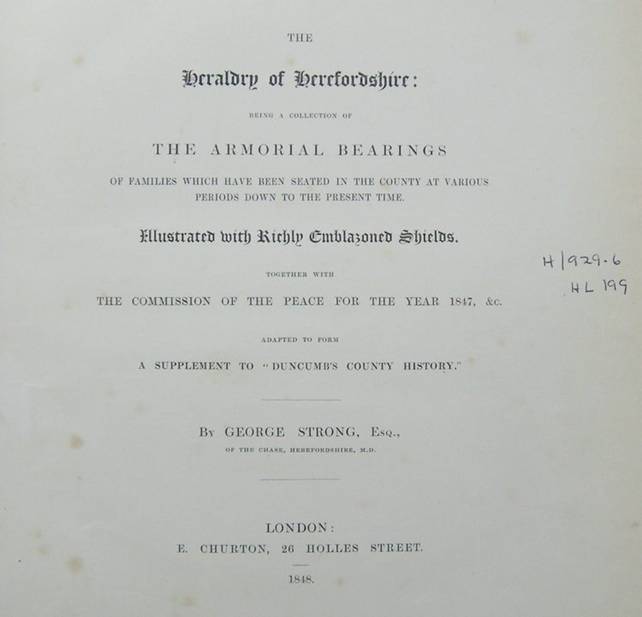Held at: | Hereford Public Library |
Reference: | H/929.6 HL 199 |
Source: | Original publication |
Title: | G. Strong: The Heraldry of Herefordshire [1848] – de Lacy Coat of Arms |
Place name: | Ewyas Lacy |
Date: | c.1200 |
Description:
The Coat of Arms [Armorial Bearings] of Walter II de Lacy [Lord of Ewyas Lacy from 1185 to 1241 – see ‘The Lordship of Ewyas Lacy’] is described in the book by George Strong entitled ‘The Heraldry of Herefordshire’, published in 1848, as follows:
“The De Lacis [sic] were a great territorial family in the county. Walter de Laci, with his brother Ilbert, were companions of the Conqueror; the former died in 1080 of a fall from the battlement of St Peter’s Church, in Hereford. One line of this race terminated in the fourth generation with Walter de Laci, who died in 1241, (see Verdon); he bore, Or a fesse gul., in chief three martlets of the second. (Pl. V.)”
A photograph of the illustration showing the Arms is reproduced below, and with the above description is the basis for the logo adopted by the Ewyas Lacy Study Group.


Observations:
Armorial bearings strictly relate to an individual rather than to a family, although in Medieval times they were often maintained by succession in practice, sometimes with the introduction of minor ‘differences’ to distinguish family members. However, it is not possible to determine whether the Coat of Arms shown here was borne by the ‘original’ Walter de Lacy in 1066 when he was part of William’s conquering army; according to some sources the use of such hereditary Arms did not become common practice until the middle of the 12th Century.
In the description of the Arms, ‘Or’ indicates a yellow or gold field [surface of the shield]; a ‘fesse’ is a band placed horizontally across the shield, occupying one third of the field; ‘Gul.’ Is short for ‘gule’ or ‘gules’ meaning coloured red; ‘Chief’ is the head or upper part of the shield, containing one third of the field; ‘Martlet’ is an imaginary bird somewhat resembling a swallow, but having short tufts of feathers in the place of legs. When used as a difference it denotes the fourth son. [ref. http://www.digiserve.com/heraldry/pimbley.htm ]
Ref: rs_ewy_0131
